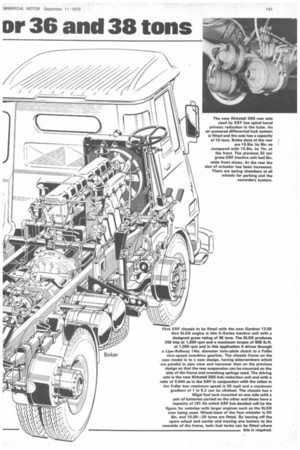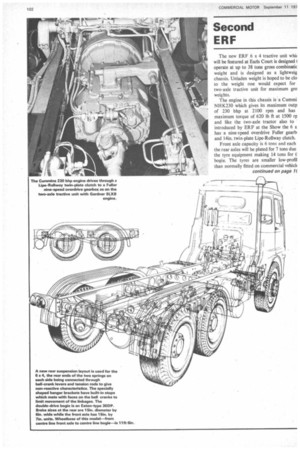ERF A-series newcomer or 36 and 38 tons
Page 98

Page 99

Page 100

Page 103

If you've noticed an error in this article please click here to report it so we can fix it.
THE FIRST RESULTS of a programme of reappraisal of its goods vehicle ranges being carried out by ERF will be the company's main exhibits at the Earls Court Show. Two new A-Series chassis will be shown--a 4 x 2 and a 6 x 4 tractive unit. A feature of these chassis is that they are designed so that any modifications needed to meet future legislation requirements and so on can readily be carried out and so that any new and improved component parts that become available can be incorporated. Another important feature of the new A-Series design is that many common parts are used on the models to allow smoother production.
A new frame which is narrower and parallel for its full length is used; this allowing outrigged, overslung rear springs with a wider spring base and therefore improved roll resistance. Any enginecurrently offered by ERF in heavier goods chassis can be accommodated in the frame and by standardizing on a particular set of ancillary units such as fuel tanks, air reservoirs and battery carriers, a wide variety of chassis types and lengths can be produced with virtually identical chassis layouts forward of the rear-spring front hangers.
It is expected that the full ERF goods range will be to the A-Series pattern within the next two years. The first two chassis give an indication of what these will be like in some respects, especially in the way that major changes in specification do not result in vehicles looking very much different externally.
A feature of the two-axle tractive unit which is designed for use at up to 36 tons (limited to 32 at present in the UK) is the use of the new Gardner 8LXB 240 bhp engine. This extends farther back in the chassis than the Cummins 230 bhp diesel in the 6 x 4 tractive unit but components are generally in the same positions and it is noteworthy that the inside of the frame is clear of ancillaries.
In the 4 x 2 the drive is through a Lipe-Rollway 14in.-diameter twin-plate clutch to a Fuller Roadranger RT0909A nine-speed overdrive gearbox to the new Kirkstall hub-reduction driving axle. The 6 x 4 model has the same gearbox and clutch but this chassis is designed as a lightweight tractive unit for up to 38 tons gross combination weight. The aim of the design is that unladen weight will be little more than a current two-axle tractive unit for maximum weights and, to reach this object, selection of components has been made with a view to keeping weight down. Stopmaster brakes are used and the four-spring rear suspension is to a new ERF design with interconnected rear ends to give non-reactive characteristics. The rear tyre; are low-profile type but smaller than tin normal being 15-19.5.
Both the new models have a set-badl front axle which marks a return by ERF tc its practice about four years ago. Sinct introducing a set-forward front axle for it! heavy models most of the tractive • unit! produced by the company have been to tha design. The two-axle machine is to 134 shown as a chassis only, but the 6 x 4 wil have a cab with many improvements. Thi latest ERF cab design will be fitted on the x 4 and on a number of other ERF exhibits.
The new ERF 6 x 4 tractive unit whic will be featured at Earls Court is designed operate at up to 38 tons gross combinatic weight and is designed as a lightweig chassis. Unladen weight is hoped to be do to the weight one would expect for two-axle tractive unit for maximum gro weights.
The engine in this chassis is' a Cummi NHK230 which gives its maximum outp of 230 bhp at 2100 rpm and has maximum torque of 620 lb ft at 1500 rp and like the two-axle tractor also to introduced by ERF at the Show the 6 x has a nine-speed overdrive Fuller gearbi and 14in. twin-plate Lipe-Rollway clutch.
Front axle capacity is 6 tons and each the rear axles will be plated for 7 tons due the tyre equipment making 14 tons for ti bogie. The tyres are smaller low-profil than normally fitted on commercial vehich
,Ting 15-19.5. The rear bogie axles are aton-type 30DP and with a ratio of 6.43 1 the maximum speed of the vehicle in )njunction with the Fuller RT0909 ;arbox will be 51 mph and maximum 'adient capacity will be 1 in 4.5 at 38 tons oss.
The cab fitted on the Show vehicle will be to the new ERF style with revised front end and a considerable number of improvements internally including better insulation against noise, better trim and so on. Stopmaster brakes are employed at all wheels and as well as giving the advantage of reduced weight, these also allow the main and secondary brake requirements to be fulfilled fairly readily. There are two brake actuators on each unit, effort being applied to both ends of each brake shoe; by having the cylinders fed by separate circuits the legal requirement is met. On each of the rear brake units one of the single-diaphragm chambers is replaced by a spring brake actuator for parking.




















































































































































































































































